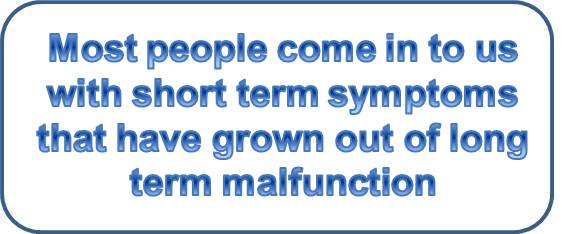How many lawyers does it take to screw in a light bulb? Answer: Six, one to change the bulb and five to write the environmental impact statement.
Let’s not just pick on lawyers. Question: How many computer scientists does it t ake to screw in a light bulb? Answer: None, that’s a hardware issue!
ake to screw in a light bulb? Answer: None, that’s a hardware issue!
Ok, let’s try one more. Question: How many psychotherapists does it take to screw in a light bulb? Answer: Only one, but the light bulb has to really want to change.
I’ve heard countless versions of this joke. Sometimes jokes contain only the smallest element of truth, while others hold profound messages. There’s even one for chiropractors. Question: How many chiropractors does it take to screw in a light bulb? Only one, but he or she needs to keep trying, and trying, and trying. Indeed, people who are new to our practice often ask us, How long is it going to take? They’re really trying to ask, When will I feel better? What that question actually reveals is that this individual thinks about caring for their health mainly when they’re in a predicament. Actually, they’re not thinking about their health at all, just how to feel better. It’s understandable since most of us have been trained that way. Let’s remember that true health is much more than just the absence of pain and symptoms. Yet the same person who says, If it ain’t broke don’t fix it diligently gets the oil changed in their car at regular intervals. It’s almost as if they care more about keeping the car running than they do their own body!
So if our health is about more than just temporarily feeling good, we should think about those things that actually help us function better, and improve our overall performance continuously. It’s what leads people into bringing their whole family in for regular chiropractic checkups, from newborn and throughout life.
People often ask us what they can do to hold their adjustments better. That’s an important question that involves many facets of a person’s life. Based on most ordinary health care experiences, they’re expecting a singular answer, to this multi-faceted question. For example, a person in pain is given a pain drug; stretching exercises are recommended for someone who is stiff; and a deep cut gets stitched up. While each of those might be a useful therapy, in actuality, a person’s well-being demands more than that. Relating it to their chiropractic care, for instance, let’s consider a typical question we hear after a practice member receives an upper neck adjustment. They might ask, “What can I do to help this stay adjusted?” It’s the right question to be asking, and the a nswer involves reconstructing the damage done by long-term subluxation. They’re expecting us to recommend a particular chemical, therapy, nutrient, or exercise, in the hopes that it will change something in their upper neck. But remember, we’re looking at the big picture, not just the short term stuff. Most people come in to us with short term symptoms that have grown out of long term malfunction that they never felt, and didn’t know they had. Subluxations in the spine are like that. They insult the body’s nerve system, creating long term damage. Without a proper nerve supply, essential communications within the body became distorted resulting in malfunction.
nswer involves reconstructing the damage done by long-term subluxation. They’re expecting us to recommend a particular chemical, therapy, nutrient, or exercise, in the hopes that it will change something in their upper neck. But remember, we’re looking at the big picture, not just the short term stuff. Most people come in to us with short term symptoms that have grown out of long term malfunction that they never felt, and didn’t know they had. Subluxations in the spine are like that. They insult the body’s nerve system, creating long term damage. Without a proper nerve supply, essential communications within the body became distorted resulting in malfunction.
Better than a quick-fix
Unfortunately, our culture has developed a quick-fix mentality, which more often than not, is a part of the problem. So often we find that people seek our care after having carried nerve interference for years before any symptoms show up. Then when symptoms suddenly appear, they look for a remedy to address what was perceived to be a short-term problem.
Now I can just about feel some reader’s frustration, sensing that lasting answers don’t come with a quick-fix. But here’s the thing, few people ever come to us first. Usually they’ve tried a few things on their own first. Then, when the issue doesn’t resolve, they go where they have faith, their family doctor. First their physician gave them medications to see if it would help. When that failed they were given another drug to try. Next they’re sent on a frustrating merry-go-round of referrals for this and that, all to no avail. It’s no wonder that they’re so discouraged. It seems like that’s usually when someone finally says, “You should go to see my chiropractor.”
Since our work is directed at improving function, rather than just changing symptoms, it empowers the body to address many underlying issues that have often been there for years. In the example of the person with a problem in the upper neck, we know that the person’s entire body must be affected by the subluxation insulting the nerve system over a period of years. Of course the most important step is to clear the nerve interference with a precise adjustment. Once the process is started, it takes time for the body to undo years of damage and begin to reconstruct itself.
Doing it right
Thankfully the wisdom within the body is able to do a lot once the interference is out of the way. The first step is to eliminate the interference, and the next step is to keep it clear. That’s why we monitor a person’s spine. Beyond that everything else matters: the food we eat; the nutrition we supplement; how much rest our body gets, and the exercise we give it; our hygiene; pure water and clean air; a positive attitude; reducing stress; giving our body time to heal by diligently keeping our chiropractic appointments; adopting healthy living habits; attention to spiritual matters; less chemical exposure, and so on.
Yes it all matters, so to get optimum results we need to take care of our whole body, not just the ailing part. By committing to improving the whole body, we literally set the stage for problems to heal. (click here for more on how long it takes)
The whole body needs good fuel, the entire body needs exercise, every cell, tissue and organ needs a good nerve supply, not just the places that hurt. One of the most important parts of answering this key question involves a focus on the future. While working to undo the damage of prolonged vertebral subluxations in adults, we shouldn’t overlook the importance of teaching our children to get their spines checked regularly. It gives them a step up on life, better performance in their school work, play and other activities, as well as a lasting legacy of good healthful living to pass on to the next generation.
So it turns out that the best part of answering this question is to bring attention to  the benefits of chiropractic care for children. Yes, for adults with long-term subluxations we can expect that a better nerve supply will improve their lives in many ways. We become aware of some of those differences right away by feeling better, and the greater benefits become more apparent over time. But for kids the advantages of improved performance are boundless since it unlocks their potentials.
the benefits of chiropractic care for children. Yes, for adults with long-term subluxations we can expect that a better nerve supply will improve their lives in many ways. We become aware of some of those differences right away by feeling better, and the greater benefits become more apparent over time. But for kids the advantages of improved performance are boundless since it unlocks their potentials.
Remember, family care is very affordable in our practice. Perhaps it’s time to consider giving your children the opportunity to grow up subluxation-free.
